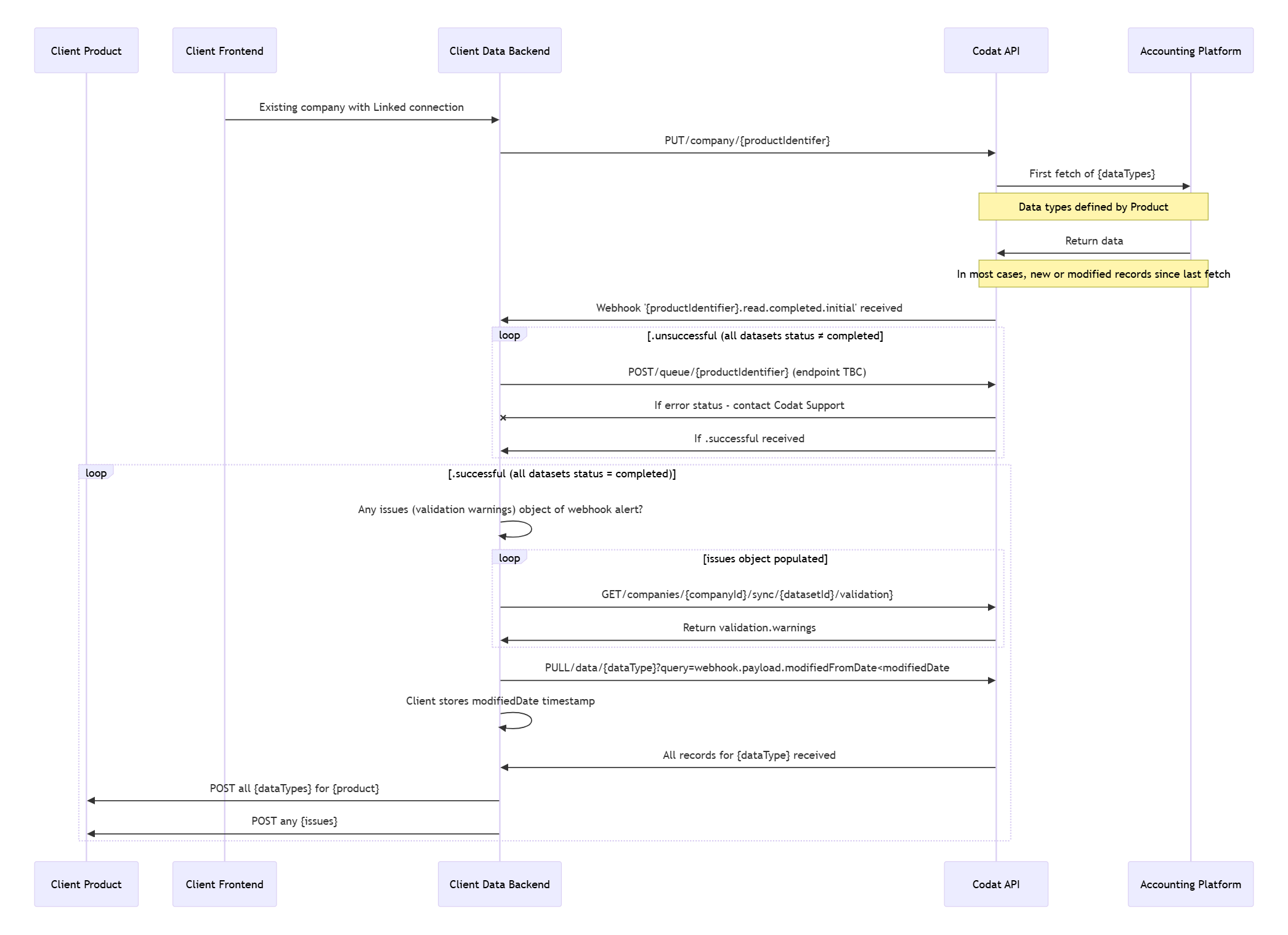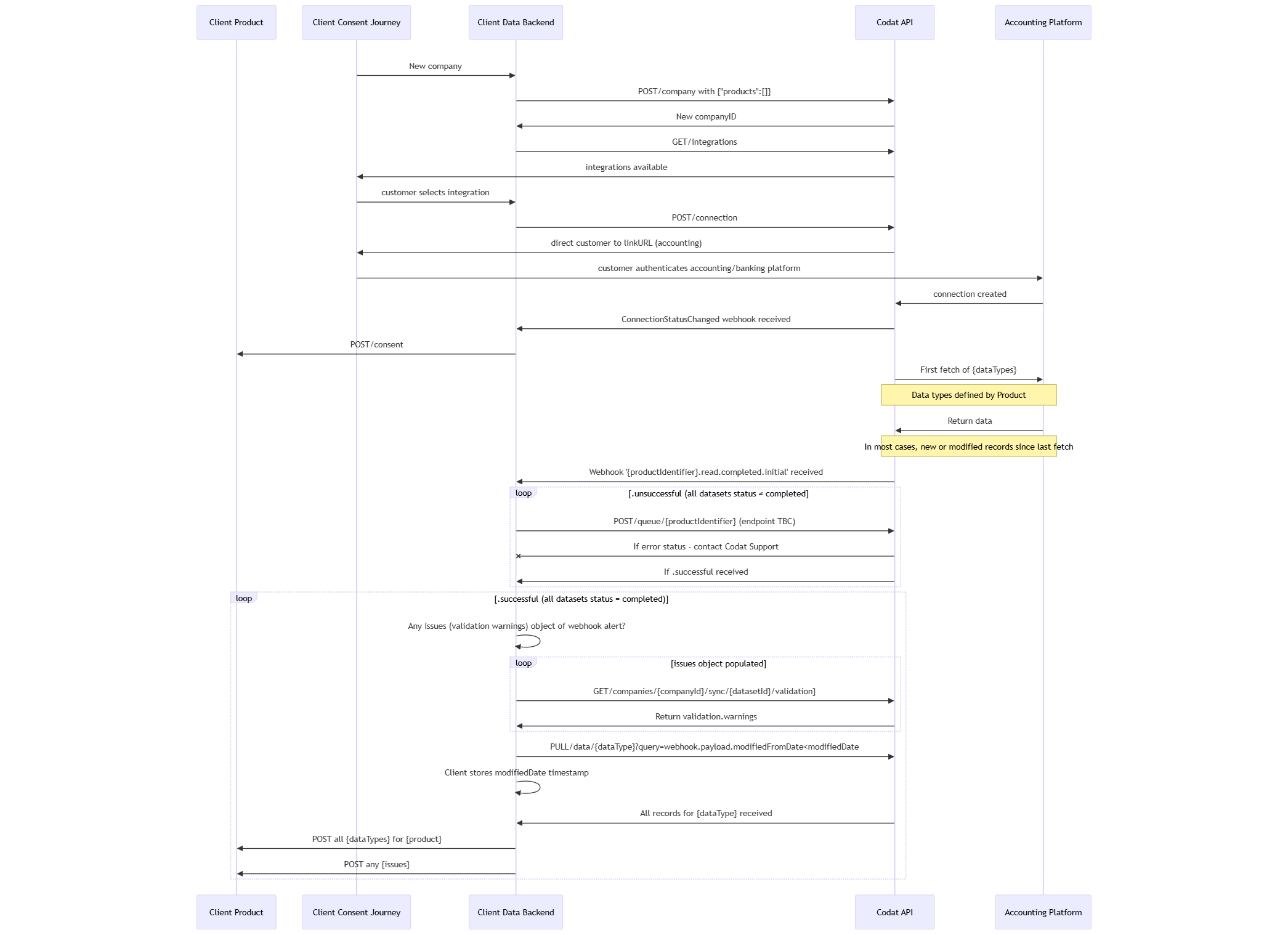Manage multiple use cases with Codat
See how your organization can use Codat's solutions to implement multiple use cases
This guide is aimed at enterprise clients who use Codat's solutions for multiple use cases and covers the following:
- Configuration required to address multiple use cases
- API requests for customers who share data for multiple use cases
- Features and specifics of Codat's solutions
Key terms and features
Products are feature packages representing a use case that can be enabled in the Codat Portal. Codat supports:
- Standard products that include data types defined by Codat as relevant and are available globally for all clients, such as Bank Feeds, Expenses, or Lending.
- Custom products that include data types requested by the client for a bespoke solution and are only available for use by that client.
You can apply sync settings that fit your use case best to these data types. Codat distinguishes:
- Client-level sync settings that are managed via Settings > Data Types in the Codat Portal.
- Product-level sync settings that are maintained by Codat upon client request.
Products are represented by an additional products property on calls to the Create company endpoint and can be added to an existing company using the Add product endpoint.
Codat's webhook service provides a range of event types for standard products. To be notified about data read events for custom products, use the {productIdentifier}.read.completed webhooks.
Assign products to companies
The following guidance is suitable for enterprise clients who have implemented Codat with a central data ingestion layer.
Create new company
You can assign a product to a company at the point of creating that company. As a result, product-level sync settings will apply to the first data fetch every time the company gains a new connection in the Linked status.

Update existing company
You can assign a product to an existing company that already has a connection in the Linked status using the Add product endpoint. The product-level sync settings will apply to the connection once the product is added.
This scenario assumes your customer has consented to the data type requirements of the additional use case.

To remove a product from an existing company, use the Remove product endpoint.
Refresh data
Refresh in the Portal
The Refresh data button in the Codat Portal uses the client-level sync settings defined in Settings > Data types when a data refresh is triggered. It doesn't use any product-level sync settings that may have been maintained.
Refresh via API
The methods listed below can't be used to refresh data for Codat's standard solutions. Refer to individual solutions' documentation instead.
If you are using client-level sync settings, you can queue a data type refresh with these settings for a company using the Refresh all data or Refresh data type endpoints.
If you are using product-level settings applied to custom products, you can refresh the data using the Refresh product data endpoint.
When refreshing data for a custom product, remember:
- If a data sync is already in progress for a custom product, the refresh request will return a
Bad request (400)response. - If a company has multiple custom products assigned, you have to refresh data for each product individually.
Manage data types in multiple products
Some data types may be required and used by multiple use cases and products. While the impact of this depends on your architecture, Codat supports product-level syncs to reduce your need for additional caching or data storage.
If your organization employs several products that share a data type, teams using these products expect to see a complete set of data that covers the sync period and frequency defined by that team. They don't want to be impacted by data syncs triggered by a different team.
It may be that:
- Product A fetches invoices and payments once a day around 11 PM.
- Product B fetches payments every hour on the hour.
Codat ensures that, for product A, the recordsModifiedFrom date will align with its previously scheduled sync and will capture all records modified after 11 PM the day before.
Custom product webhooks
Codat's webhook service supports custom {productIdentifier}.read.completed event types that will be sent to the configured endpoint when Codat has successfully fetched or exhausted fetching data.
As a result, unless you are using one of the sub-event types, such as .successful or .unsuccessful, you will see a Complete or Error status for all data types in that product.
A data type may end up in an Error state in the following scenario:
- Codat tries to perform a scheduled daily sync defined by product-level sync settings for a
Linkedconnection. - The linked accounting software is experiencing downtime.
- Codat receives an error response from the accounting software.
- Codat retries the data sync up to 10 times over a 12-hour period and continues receiving error responses from the software.
- Codat flags the data set with a
FetchErrorstatus and sends aread.completedwebhook.
Specific event types
You may choose to receive webhooks for more specific event types, such as successful or unsuccessful reads:
read.completed.successfulor{productIdentifer}.read.completed.successfulare sent of all data types have synced successfully. The synced data types may have validation warnings, but not validation errors.read.completed.unsuccessfulor{productIdentifer}.read.completed.unsuccessfulare sent if Codat has completed the fetch for all data types, but some have completed with errors.
The first webhook you receive after an initial successful company connection (this could be a read.completed.successful.initial, read.completed.successful or read.completed event type) will present recordsModified as false. Next time you receive a notification from a read.completed event, such as after the next scheduled sync, you will see a true reflection of any record modifications since that first fetch of data.
Implementation considerations
The plan below reflects the activities required to migrate company syncs from using client-level sync settings to product-specific sync settings.
| # | Activity | Impact on webhooks | Impact on sync | Rollback actions |
|---|---|---|---|---|
| 1 | Disable client-level sync settings | No further syncs scheduled except those already triggered | Re-enable client-level sync settings | |
| 2 | Wait for an hour or for the duration of the most frequent previous sync schedule | Allows any client-level syncs already in progress to complete | Re-enable client-level sync settings | |
| 3 | Disable previous webhook configuration | Event notifications will no longer be sent | 1. Resubscribe to previously disabled webhook events 2. Re-enable client-level sync settings | |
| 4 | Configure webhooks for new event types | Standard products: subscribe to read.completed event types. Custom products: subscribe to {productIdentifier}.read.completed event types. | 1. Unsubscribe from the new event types 2.Resubscribe to previously disabled webhook event types 3. Re-enable client-level sync settings | |
| 5 | Add products to all companies using the Add product endpoint | This will trigger a fetch of the product’s data types for the updated companies | 1. Remove product from the company 2. Unsubscribe from the new event type series 3. Resubscribe to previously disabled webhook event types 4. Re-enable client-level sync settings |
Additional considerations
When planning to implement multi-use case support, assess how this change may impact the following areas:
-
Environment management: do you have multiple development, testing, and staging environments?
-
Developer apps with partners: will you require more than one developer app for each accounting integration you support?
-
Consent journey: how will you ask your customers for additional consent in a transparent and compliant way?
For more information on implementing multi-use case support, get in touch with your Codat contact.